Team Dynamics and Leadership: A Reflection on PechaKucha Presentation
VerifiedAdded on 2023/06/08
|10
|2312
|261
AI Summary
This report reflects on the team experience while making PechaKucha presentation where the team members undertook tutorial presentation and discussion assignments. It identifies academic literature related to team dynamics and leadership, the characters and role of other team members during the presentation.
Contribute Materials
Your contribution can guide someone’s learning journey. Share your
documents today.
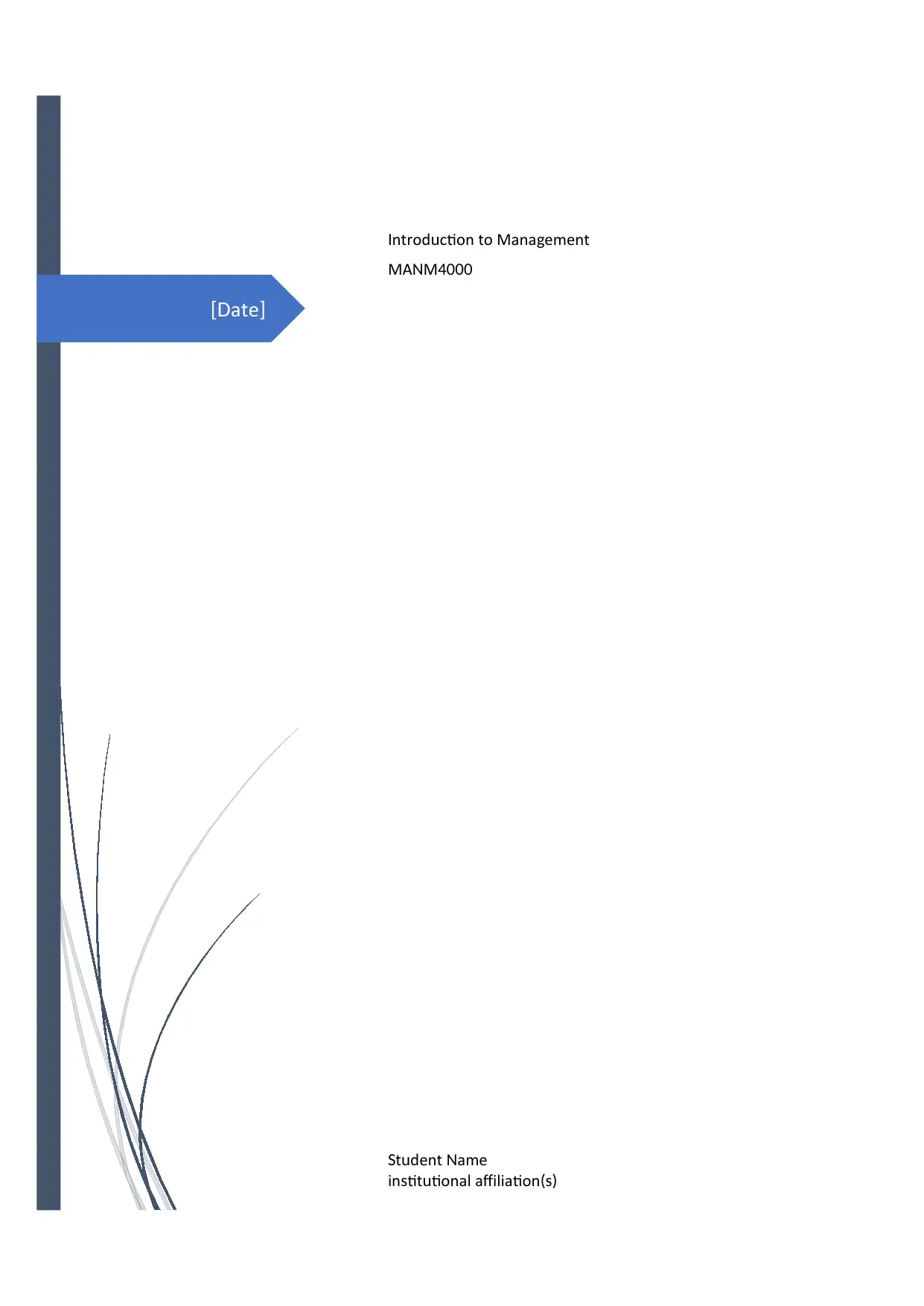
ate[D ]
ntrod ction to Mana ementI u g
MA MN 4000
t dent ameS u N
in tit tional a iliations u ff (s)
ntrod ction to Mana ementI u g
MA MN 4000
t dent ameS u N
in tit tional a iliations u ff (s)
Secure Best Marks with AI Grader
Need help grading? Try our AI Grader for instant feedback on your assignments.
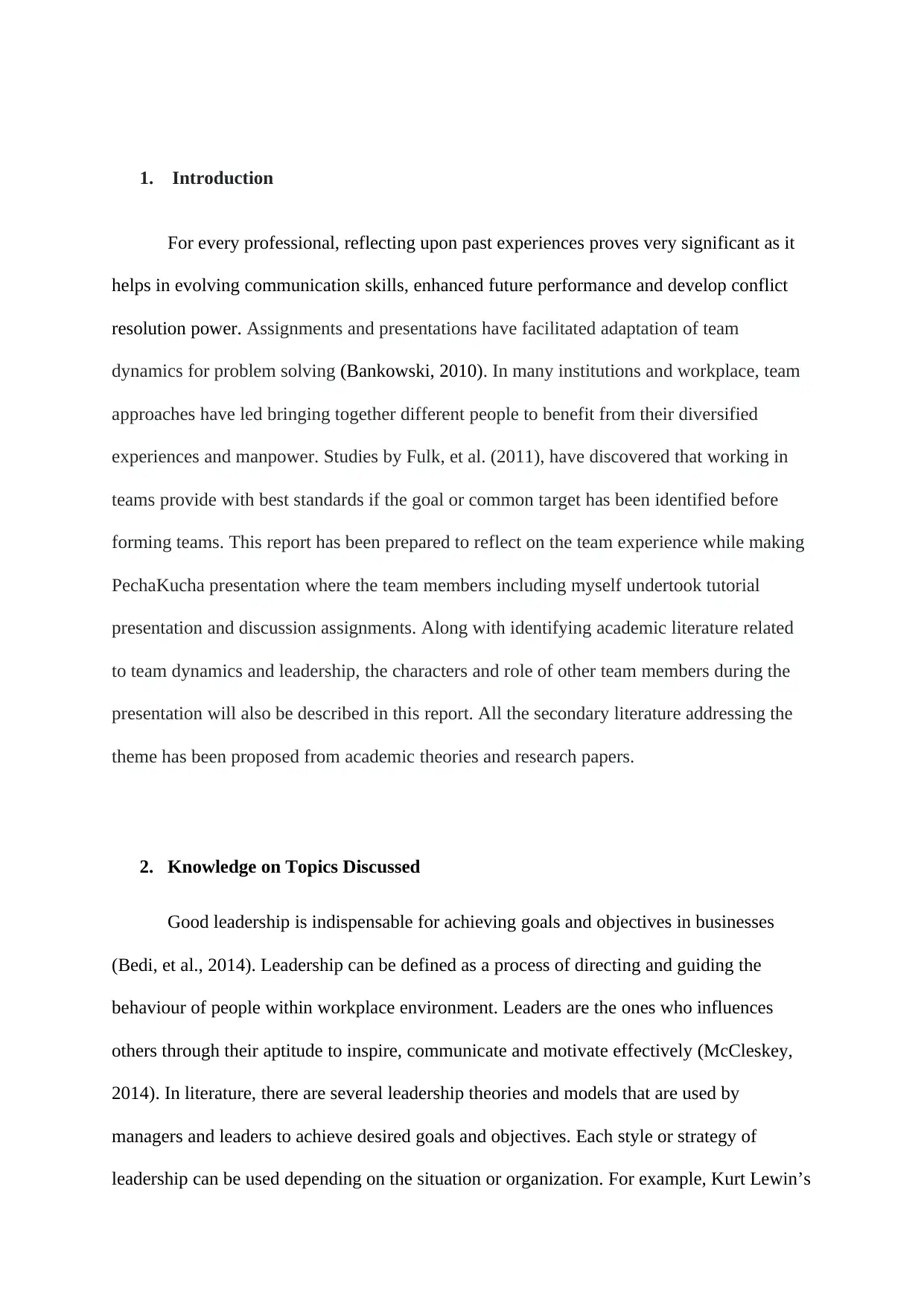
1. Introduction
For every professional, reflecting upon past experiences proves very significant as it
helps in evolving communication skills, enhanced future performance and develop conflict
resolution power. Assignments and presentations have facilitated adaptation of team
dynamics for problem solving (Bankowski, 2010). In many institutions and workplace, team
approaches have led bringing together different people to benefit from their diversified
experiences and manpower. Studies by Fulk, et al. (2011), have discovered that working in
teams provide with best standards if the goal or common target has been identified before
forming teams. This report has been prepared to reflect on the team experience while making
PechaKucha presentation where the team members including myself undertook tutorial
presentation and discussion assignments. Along with identifying academic literature related
to team dynamics and leadership, the characters and role of other team members during the
presentation will also be described in this report. All the secondary literature addressing the
theme has been proposed from academic theories and research papers.
2. Knowledge on Topics Discussed
Good leadership is indispensable for achieving goals and objectives in businesses
(Bedi, et al., 2014). Leadership can be defined as a process of directing and guiding the
behaviour of people within workplace environment. Leaders are the ones who influences
others through their aptitude to inspire, communicate and motivate effectively (McCleskey,
2014). In literature, there are several leadership theories and models that are used by
managers and leaders to achieve desired goals and objectives. Each style or strategy of
leadership can be used depending on the situation or organization. For example, Kurt Lewin’s
For every professional, reflecting upon past experiences proves very significant as it
helps in evolving communication skills, enhanced future performance and develop conflict
resolution power. Assignments and presentations have facilitated adaptation of team
dynamics for problem solving (Bankowski, 2010). In many institutions and workplace, team
approaches have led bringing together different people to benefit from their diversified
experiences and manpower. Studies by Fulk, et al. (2011), have discovered that working in
teams provide with best standards if the goal or common target has been identified before
forming teams. This report has been prepared to reflect on the team experience while making
PechaKucha presentation where the team members including myself undertook tutorial
presentation and discussion assignments. Along with identifying academic literature related
to team dynamics and leadership, the characters and role of other team members during the
presentation will also be described in this report. All the secondary literature addressing the
theme has been proposed from academic theories and research papers.
2. Knowledge on Topics Discussed
Good leadership is indispensable for achieving goals and objectives in businesses
(Bedi, et al., 2014). Leadership can be defined as a process of directing and guiding the
behaviour of people within workplace environment. Leaders are the ones who influences
others through their aptitude to inspire, communicate and motivate effectively (McCleskey,
2014). In literature, there are several leadership theories and models that are used by
managers and leaders to achieve desired goals and objectives. Each style or strategy of
leadership can be used depending on the situation or organization. For example, Kurt Lewin’s
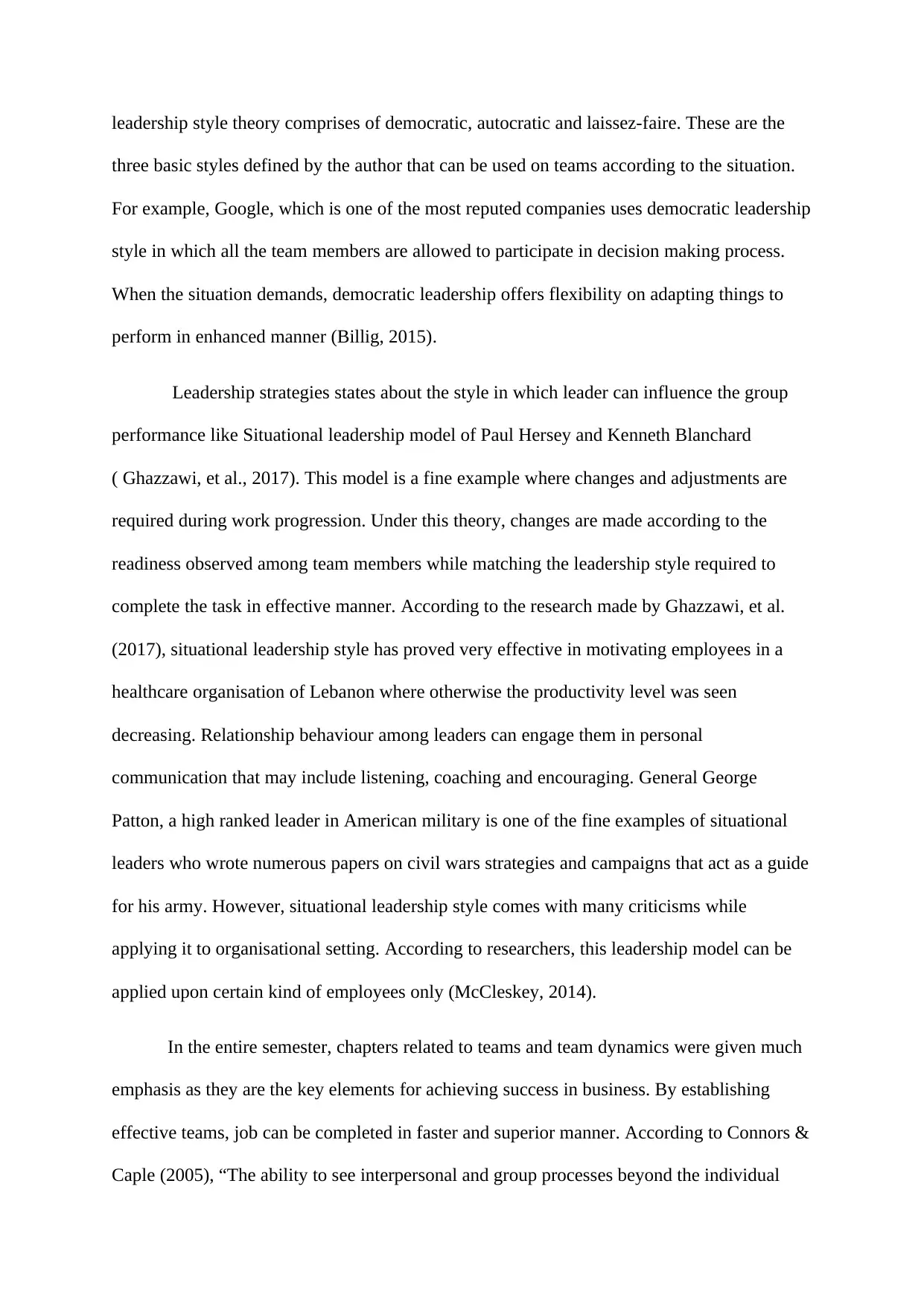
leadership style theory comprises of democratic, autocratic and laissez-faire. These are the
three basic styles defined by the author that can be used on teams according to the situation.
For example, Google, which is one of the most reputed companies uses democratic leadership
style in which all the team members are allowed to participate in decision making process.
When the situation demands, democratic leadership offers flexibility on adapting things to
perform in enhanced manner (Billig, 2015).
Leadership strategies states about the style in which leader can influence the group
performance like Situational leadership model of Paul Hersey and Kenneth Blanchard
( Ghazzawi, et al., 2017). This model is a fine example where changes and adjustments are
required during work progression. Under this theory, changes are made according to the
readiness observed among team members while matching the leadership style required to
complete the task in effective manner. According to the research made by Ghazzawi, et al.
(2017), situational leadership style has proved very effective in motivating employees in a
healthcare organisation of Lebanon where otherwise the productivity level was seen
decreasing. Relationship behaviour among leaders can engage them in personal
communication that may include listening, coaching and encouraging. General George
Patton, a high ranked leader in American military is one of the fine examples of situational
leaders who wrote numerous papers on civil wars strategies and campaigns that act as a guide
for his army. However, situational leadership style comes with many criticisms while
applying it to organisational setting. According to researchers, this leadership model can be
applied upon certain kind of employees only (McCleskey, 2014).
In the entire semester, chapters related to teams and team dynamics were given much
emphasis as they are the key elements for achieving success in business. By establishing
effective teams, job can be completed in faster and superior manner. According to Connors &
Caple (2005), “The ability to see interpersonal and group processes beyond the individual
three basic styles defined by the author that can be used on teams according to the situation.
For example, Google, which is one of the most reputed companies uses democratic leadership
style in which all the team members are allowed to participate in decision making process.
When the situation demands, democratic leadership offers flexibility on adapting things to
perform in enhanced manner (Billig, 2015).
Leadership strategies states about the style in which leader can influence the group
performance like Situational leadership model of Paul Hersey and Kenneth Blanchard
( Ghazzawi, et al., 2017). This model is a fine example where changes and adjustments are
required during work progression. Under this theory, changes are made according to the
readiness observed among team members while matching the leadership style required to
complete the task in effective manner. According to the research made by Ghazzawi, et al.
(2017), situational leadership style has proved very effective in motivating employees in a
healthcare organisation of Lebanon where otherwise the productivity level was seen
decreasing. Relationship behaviour among leaders can engage them in personal
communication that may include listening, coaching and encouraging. General George
Patton, a high ranked leader in American military is one of the fine examples of situational
leaders who wrote numerous papers on civil wars strategies and campaigns that act as a guide
for his army. However, situational leadership style comes with many criticisms while
applying it to organisational setting. According to researchers, this leadership model can be
applied upon certain kind of employees only (McCleskey, 2014).
In the entire semester, chapters related to teams and team dynamics were given much
emphasis as they are the key elements for achieving success in business. By establishing
effective teams, job can be completed in faster and superior manner. According to Connors &
Caple (2005), “The ability to see interpersonal and group processes beyond the individual
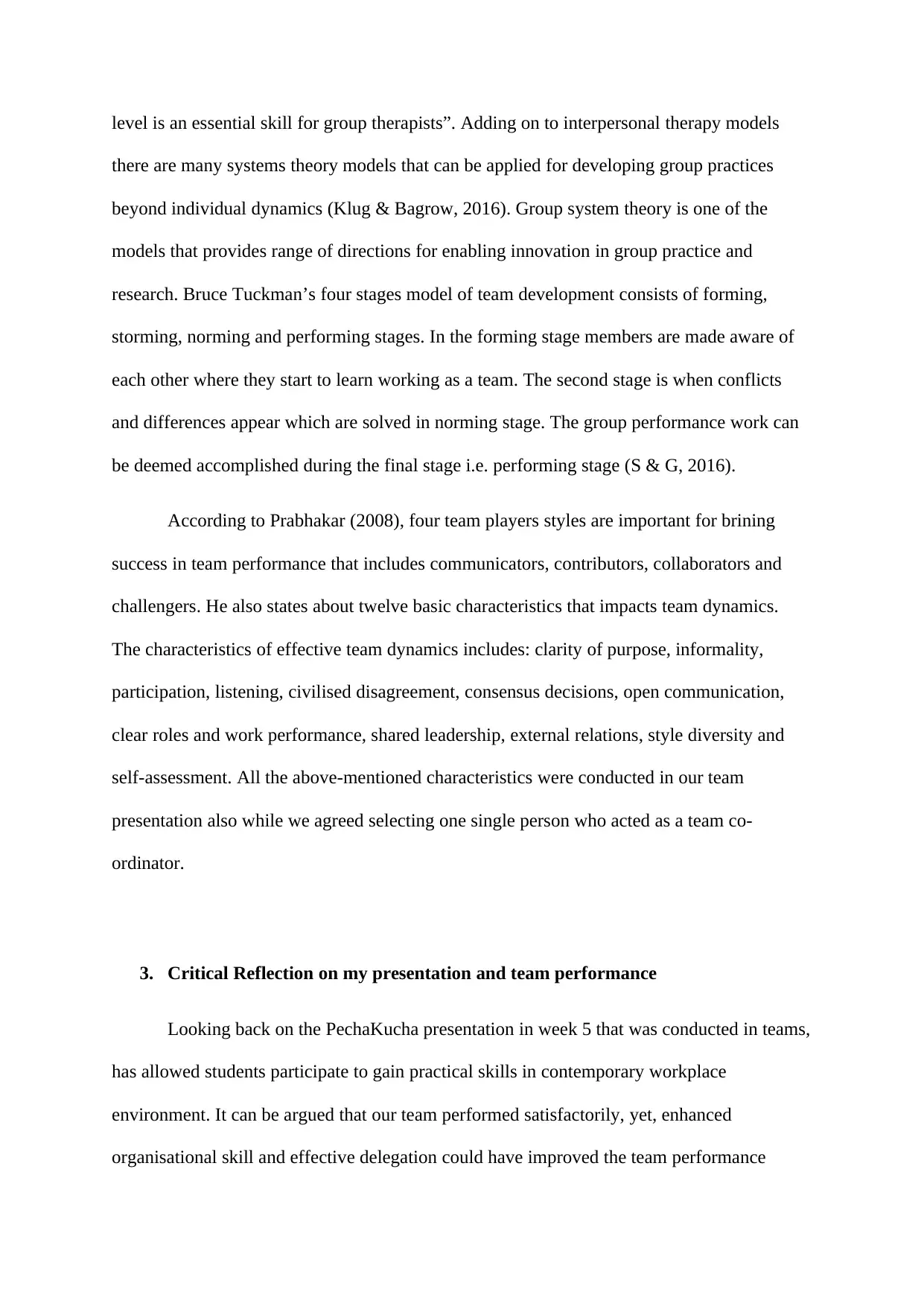
level is an essential skill for group therapists”. Adding on to interpersonal therapy models
there are many systems theory models that can be applied for developing group practices
beyond individual dynamics (Klug & Bagrow, 2016). Group system theory is one of the
models that provides range of directions for enabling innovation in group practice and
research. Bruce Tuckman’s four stages model of team development consists of forming,
storming, norming and performing stages. In the forming stage members are made aware of
each other where they start to learn working as a team. The second stage is when conflicts
and differences appear which are solved in norming stage. The group performance work can
be deemed accomplished during the final stage i.e. performing stage (S & G, 2016).
According to Prabhakar (2008), four team players styles are important for brining
success in team performance that includes communicators, contributors, collaborators and
challengers. He also states about twelve basic characteristics that impacts team dynamics.
The characteristics of effective team dynamics includes: clarity of purpose, informality,
participation, listening, civilised disagreement, consensus decisions, open communication,
clear roles and work performance, shared leadership, external relations, style diversity and
self-assessment. All the above-mentioned characteristics were conducted in our team
presentation also while we agreed selecting one single person who acted as a team co-
ordinator.
3. Critical Reflection on my presentation and team performance
Looking back on the PechaKucha presentation in week 5 that was conducted in teams,
has allowed students participate to gain practical skills in contemporary workplace
environment. It can be argued that our team performed satisfactorily, yet, enhanced
organisational skill and effective delegation could have improved the team performance
there are many systems theory models that can be applied for developing group practices
beyond individual dynamics (Klug & Bagrow, 2016). Group system theory is one of the
models that provides range of directions for enabling innovation in group practice and
research. Bruce Tuckman’s four stages model of team development consists of forming,
storming, norming and performing stages. In the forming stage members are made aware of
each other where they start to learn working as a team. The second stage is when conflicts
and differences appear which are solved in norming stage. The group performance work can
be deemed accomplished during the final stage i.e. performing stage (S & G, 2016).
According to Prabhakar (2008), four team players styles are important for brining
success in team performance that includes communicators, contributors, collaborators and
challengers. He also states about twelve basic characteristics that impacts team dynamics.
The characteristics of effective team dynamics includes: clarity of purpose, informality,
participation, listening, civilised disagreement, consensus decisions, open communication,
clear roles and work performance, shared leadership, external relations, style diversity and
self-assessment. All the above-mentioned characteristics were conducted in our team
presentation also while we agreed selecting one single person who acted as a team co-
ordinator.
3. Critical Reflection on my presentation and team performance
Looking back on the PechaKucha presentation in week 5 that was conducted in teams,
has allowed students participate to gain practical skills in contemporary workplace
environment. It can be argued that our team performed satisfactorily, yet, enhanced
organisational skill and effective delegation could have improved the team performance
Secure Best Marks with AI Grader
Need help grading? Try our AI Grader for instant feedback on your assignments.
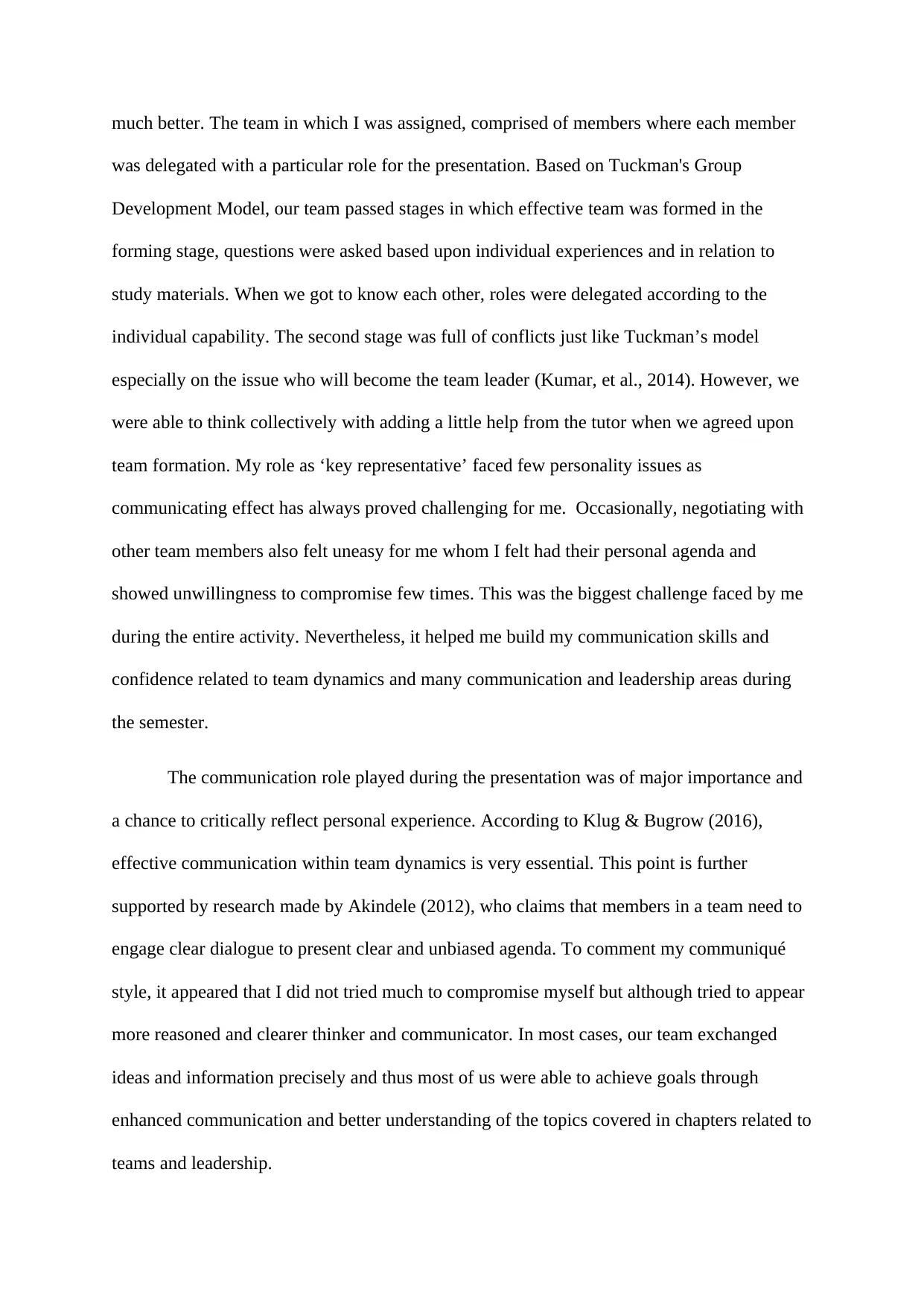
much better. The team in which I was assigned, comprised of members where each member
was delegated with a particular role for the presentation. Based on Tuckman's Group
Development Model, our team passed stages in which effective team was formed in the
forming stage, questions were asked based upon individual experiences and in relation to
study materials. When we got to know each other, roles were delegated according to the
individual capability. The second stage was full of conflicts just like Tuckman’s model
especially on the issue who will become the team leader (Kumar, et al., 2014). However, we
were able to think collectively with adding a little help from the tutor when we agreed upon
team formation. My role as ‘key representative’ faced few personality issues as
communicating effect has always proved challenging for me. Occasionally, negotiating with
other team members also felt uneasy for me whom I felt had their personal agenda and
showed unwillingness to compromise few times. This was the biggest challenge faced by me
during the entire activity. Nevertheless, it helped me build my communication skills and
confidence related to team dynamics and many communication and leadership areas during
the semester.
The communication role played during the presentation was of major importance and
a chance to critically reflect personal experience. According to Klug & Bugrow (2016),
effective communication within team dynamics is very essential. This point is further
supported by research made by Akindele (2012), who claims that members in a team need to
engage clear dialogue to present clear and unbiased agenda. To comment my communiqué
style, it appeared that I did not tried much to compromise myself but although tried to appear
more reasoned and clearer thinker and communicator. In most cases, our team exchanged
ideas and information precisely and thus most of us were able to achieve goals through
enhanced communication and better understanding of the topics covered in chapters related to
teams and leadership.
was delegated with a particular role for the presentation. Based on Tuckman's Group
Development Model, our team passed stages in which effective team was formed in the
forming stage, questions were asked based upon individual experiences and in relation to
study materials. When we got to know each other, roles were delegated according to the
individual capability. The second stage was full of conflicts just like Tuckman’s model
especially on the issue who will become the team leader (Kumar, et al., 2014). However, we
were able to think collectively with adding a little help from the tutor when we agreed upon
team formation. My role as ‘key representative’ faced few personality issues as
communicating effect has always proved challenging for me. Occasionally, negotiating with
other team members also felt uneasy for me whom I felt had their personal agenda and
showed unwillingness to compromise few times. This was the biggest challenge faced by me
during the entire activity. Nevertheless, it helped me build my communication skills and
confidence related to team dynamics and many communication and leadership areas during
the semester.
The communication role played during the presentation was of major importance and
a chance to critically reflect personal experience. According to Klug & Bugrow (2016),
effective communication within team dynamics is very essential. This point is further
supported by research made by Akindele (2012), who claims that members in a team need to
engage clear dialogue to present clear and unbiased agenda. To comment my communiqué
style, it appeared that I did not tried much to compromise myself but although tried to appear
more reasoned and clearer thinker and communicator. In most cases, our team exchanged
ideas and information precisely and thus most of us were able to achieve goals through
enhanced communication and better understanding of the topics covered in chapters related to
teams and leadership.
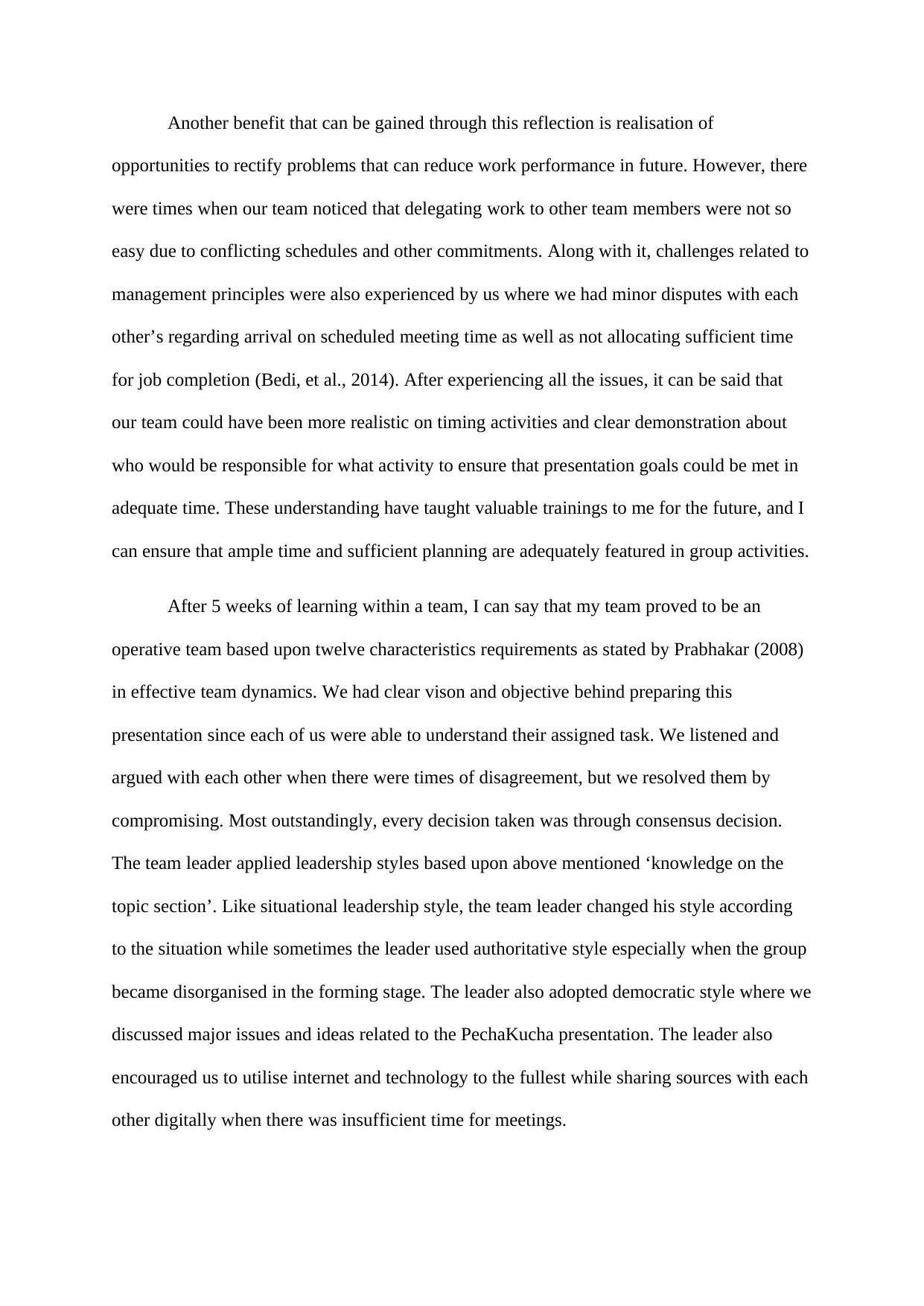
Another benefit that can be gained through this reflection is realisation of
opportunities to rectify problems that can reduce work performance in future. However, there
were times when our team noticed that delegating work to other team members were not so
easy due to conflicting schedules and other commitments. Along with it, challenges related to
management principles were also experienced by us where we had minor disputes with each
other’s regarding arrival on scheduled meeting time as well as not allocating sufficient time
for job completion (Bedi, et al., 2014). After experiencing all the issues, it can be said that
our team could have been more realistic on timing activities and clear demonstration about
who would be responsible for what activity to ensure that presentation goals could be met in
adequate time. These understanding have taught valuable trainings to me for the future, and I
can ensure that ample time and sufficient planning are adequately featured in group activities.
After 5 weeks of learning within a team, I can say that my team proved to be an
operative team based upon twelve characteristics requirements as stated by Prabhakar (2008)
in effective team dynamics. We had clear vison and objective behind preparing this
presentation since each of us were able to understand their assigned task. We listened and
argued with each other when there were times of disagreement, but we resolved them by
compromising. Most outstandingly, every decision taken was through consensus decision.
The team leader applied leadership styles based upon above mentioned ‘knowledge on the
topic section’. Like situational leadership style, the team leader changed his style according
to the situation while sometimes the leader used authoritative style especially when the group
became disorganised in the forming stage. The leader also adopted democratic style where we
discussed major issues and ideas related to the PechaKucha presentation. The leader also
encouraged us to utilise internet and technology to the fullest while sharing sources with each
other digitally when there was insufficient time for meetings.
opportunities to rectify problems that can reduce work performance in future. However, there
were times when our team noticed that delegating work to other team members were not so
easy due to conflicting schedules and other commitments. Along with it, challenges related to
management principles were also experienced by us where we had minor disputes with each
other’s regarding arrival on scheduled meeting time as well as not allocating sufficient time
for job completion (Bedi, et al., 2014). After experiencing all the issues, it can be said that
our team could have been more realistic on timing activities and clear demonstration about
who would be responsible for what activity to ensure that presentation goals could be met in
adequate time. These understanding have taught valuable trainings to me for the future, and I
can ensure that ample time and sufficient planning are adequately featured in group activities.
After 5 weeks of learning within a team, I can say that my team proved to be an
operative team based upon twelve characteristics requirements as stated by Prabhakar (2008)
in effective team dynamics. We had clear vison and objective behind preparing this
presentation since each of us were able to understand their assigned task. We listened and
argued with each other when there were times of disagreement, but we resolved them by
compromising. Most outstandingly, every decision taken was through consensus decision.
The team leader applied leadership styles based upon above mentioned ‘knowledge on the
topic section’. Like situational leadership style, the team leader changed his style according
to the situation while sometimes the leader used authoritative style especially when the group
became disorganised in the forming stage. The leader also adopted democratic style where we
discussed major issues and ideas related to the PechaKucha presentation. The leader also
encouraged us to utilise internet and technology to the fullest while sharing sources with each
other digitally when there was insufficient time for meetings.
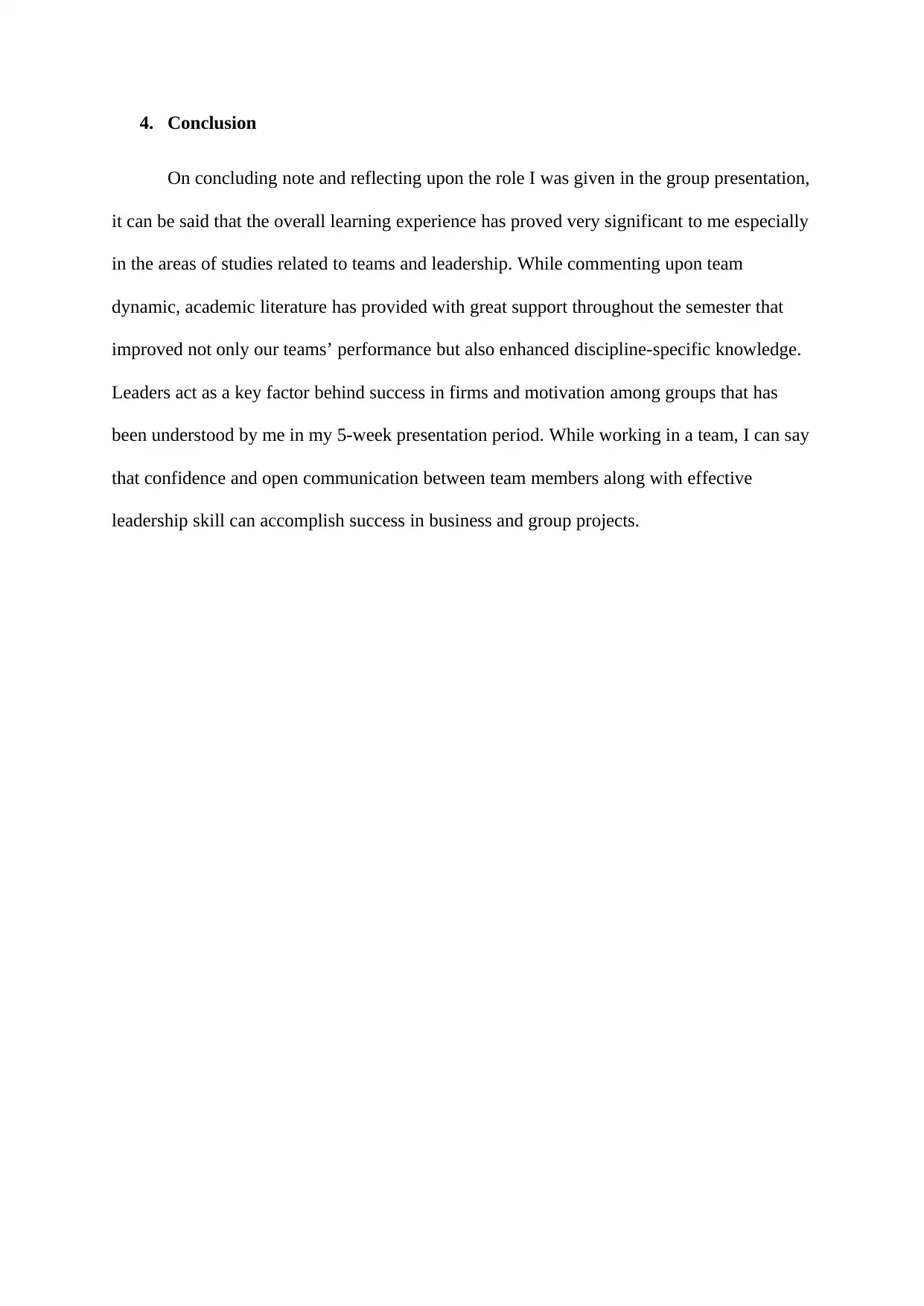
4. Conclusion
On concluding note and reflecting upon the role I was given in the group presentation,
it can be said that the overall learning experience has proved very significant to me especially
in the areas of studies related to teams and leadership. While commenting upon team
dynamic, academic literature has provided with great support throughout the semester that
improved not only our teams’ performance but also enhanced discipline-specific knowledge.
Leaders act as a key factor behind success in firms and motivation among groups that has
been understood by me in my 5-week presentation period. While working in a team, I can say
that confidence and open communication between team members along with effective
leadership skill can accomplish success in business and group projects.
On concluding note and reflecting upon the role I was given in the group presentation,
it can be said that the overall learning experience has proved very significant to me especially
in the areas of studies related to teams and leadership. While commenting upon team
dynamic, academic literature has provided with great support throughout the semester that
improved not only our teams’ performance but also enhanced discipline-specific knowledge.
Leaders act as a key factor behind success in firms and motivation among groups that has
been understood by me in my 5-week presentation period. While working in a team, I can say
that confidence and open communication between team members along with effective
leadership skill can accomplish success in business and group projects.
Paraphrase This Document
Need a fresh take? Get an instant paraphrase of this document with our AI Paraphraser
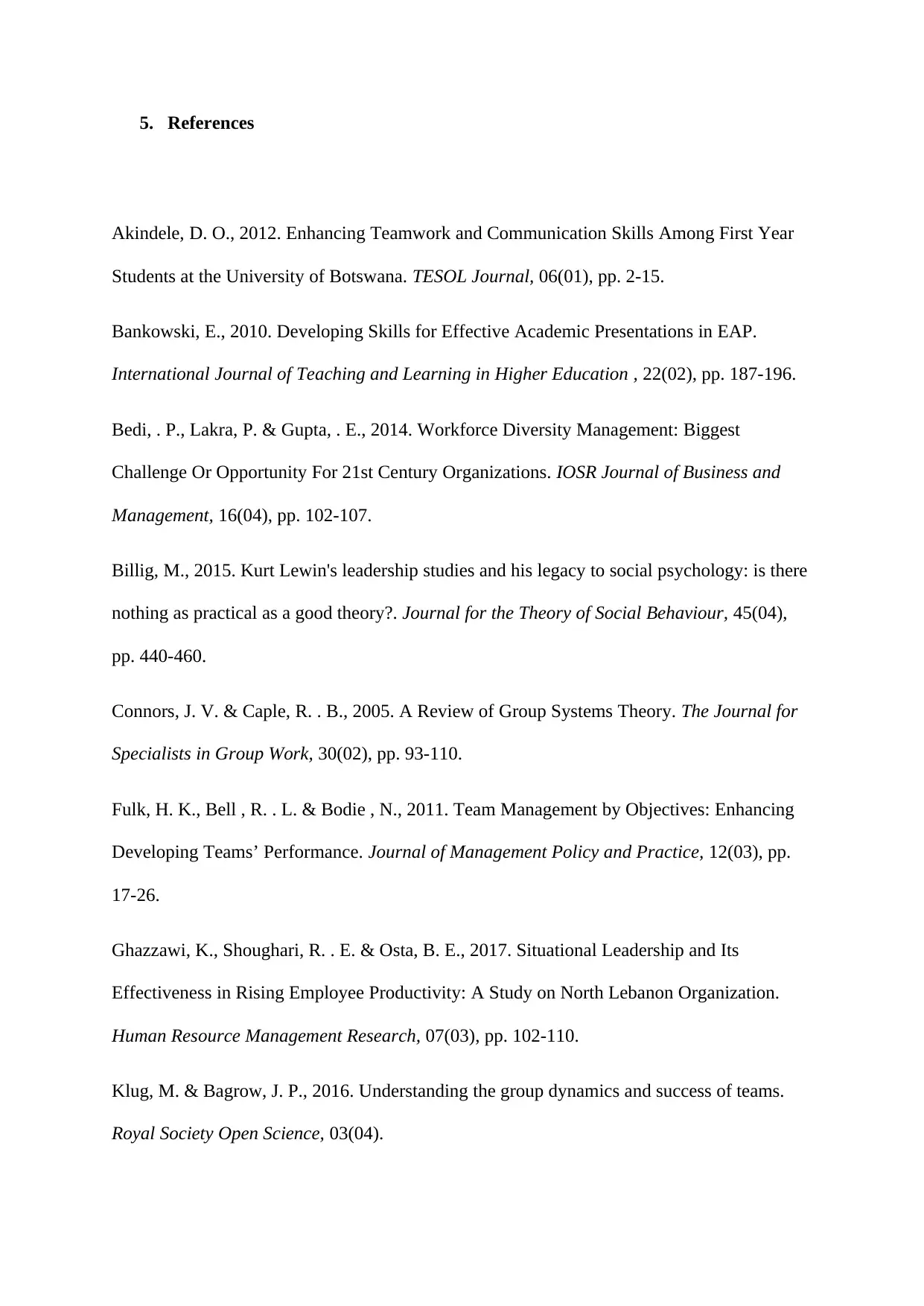
5. References
Akindele, D. O., 2012. Enhancing Teamwork and Communication Skills Among First Year
Students at the University of Botswana. TESOL Journal, 06(01), pp. 2-15.
Bankowski, E., 2010. Developing Skills for Effective Academic Presentations in EAP.
International Journal of Teaching and Learning in Higher Education , 22(02), pp. 187-196.
Bedi, . P., Lakra, P. & Gupta, . E., 2014. Workforce Diversity Management: Biggest
Challenge Or Opportunity For 21st Century Organizations. IOSR Journal of Business and
Management, 16(04), pp. 102-107.
Billig, M., 2015. Kurt Lewin's leadership studies and his legacy to social psychology: is there
nothing as practical as a good theory?. Journal for the Theory of Social Behaviour, 45(04),
pp. 440-460.
Connors, J. V. & Caple, R. . B., 2005. A Review of Group Systems Theory. The Journal for
Specialists in Group Work, 30(02), pp. 93-110.
Fulk, H. K., Bell , R. . L. & Bodie , N., 2011. Team Management by Objectives: Enhancing
Developing Teams’ Performance. Journal of Management Policy and Practice, 12(03), pp.
17-26.
Ghazzawi, K., Shoughari, R. . E. & Osta, B. E., 2017. Situational Leadership and Its
Effectiveness in Rising Employee Productivity: A Study on North Lebanon Organization.
Human Resource Management Research, 07(03), pp. 102-110.
Klug, M. & Bagrow, J. P., 2016. Understanding the group dynamics and success of teams.
Royal Society Open Science, 03(04).
Akindele, D. O., 2012. Enhancing Teamwork and Communication Skills Among First Year
Students at the University of Botswana. TESOL Journal, 06(01), pp. 2-15.
Bankowski, E., 2010. Developing Skills for Effective Academic Presentations in EAP.
International Journal of Teaching and Learning in Higher Education , 22(02), pp. 187-196.
Bedi, . P., Lakra, P. & Gupta, . E., 2014. Workforce Diversity Management: Biggest
Challenge Or Opportunity For 21st Century Organizations. IOSR Journal of Business and
Management, 16(04), pp. 102-107.
Billig, M., 2015. Kurt Lewin's leadership studies and his legacy to social psychology: is there
nothing as practical as a good theory?. Journal for the Theory of Social Behaviour, 45(04),
pp. 440-460.
Connors, J. V. & Caple, R. . B., 2005. A Review of Group Systems Theory. The Journal for
Specialists in Group Work, 30(02), pp. 93-110.
Fulk, H. K., Bell , R. . L. & Bodie , N., 2011. Team Management by Objectives: Enhancing
Developing Teams’ Performance. Journal of Management Policy and Practice, 12(03), pp.
17-26.
Ghazzawi, K., Shoughari, R. . E. & Osta, B. E., 2017. Situational Leadership and Its
Effectiveness in Rising Employee Productivity: A Study on North Lebanon Organization.
Human Resource Management Research, 07(03), pp. 102-110.
Klug, M. & Bagrow, J. P., 2016. Understanding the group dynamics and success of teams.
Royal Society Open Science, 03(04).
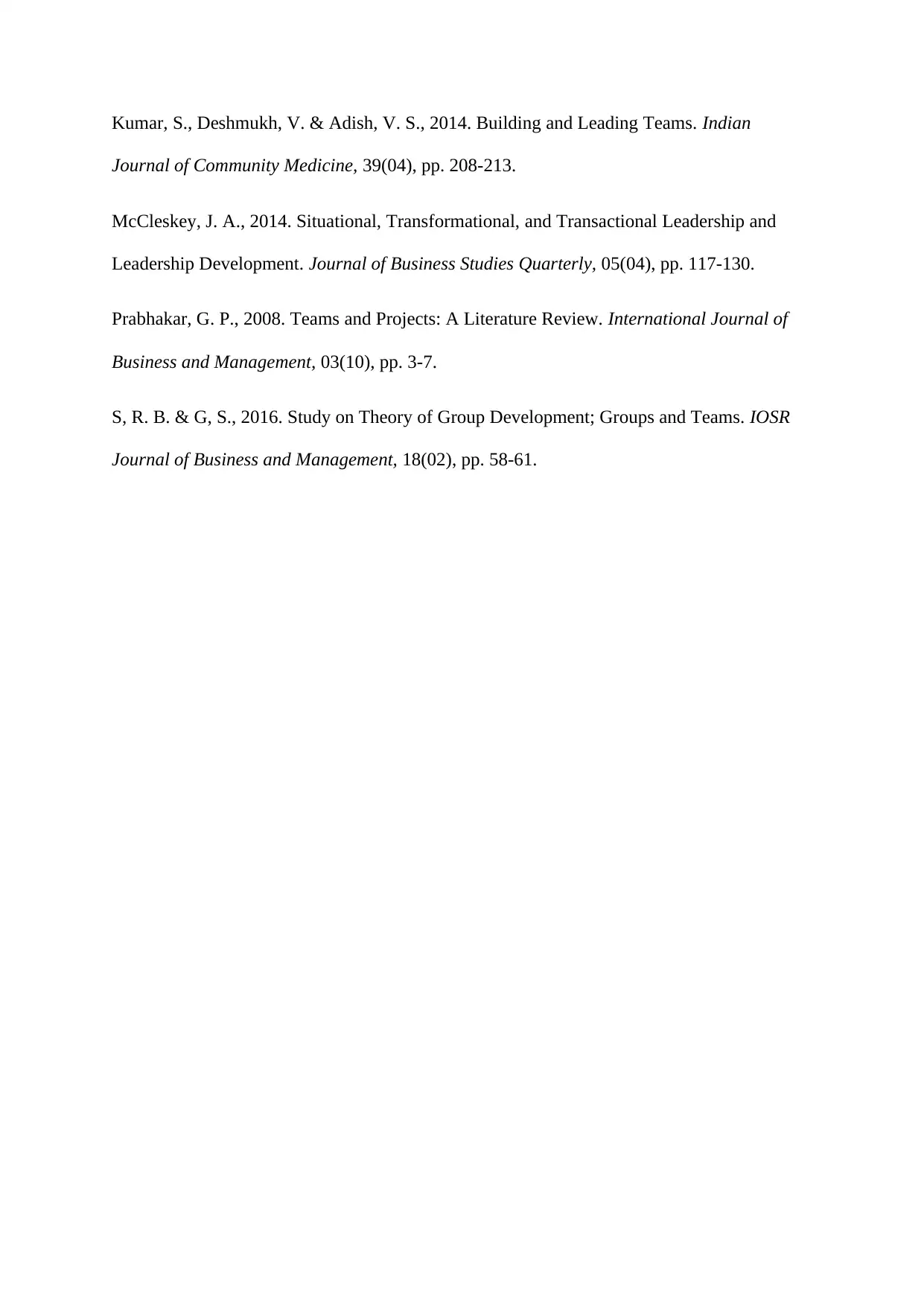
Kumar, S., Deshmukh, V. & Adish, V. S., 2014. Building and Leading Teams. Indian
Journal of Community Medicine, 39(04), pp. 208-213.
McCleskey, J. A., 2014. Situational, Transformational, and Transactional Leadership and
Leadership Development. Journal of Business Studies Quarterly, 05(04), pp. 117-130.
Prabhakar, G. P., 2008. Teams and Projects: A Literature Review. International Journal of
Business and Management, 03(10), pp. 3-7.
S, R. B. & G, S., 2016. Study on Theory of Group Development; Groups and Teams. IOSR
Journal of Business and Management, 18(02), pp. 58-61.
Journal of Community Medicine, 39(04), pp. 208-213.
McCleskey, J. A., 2014. Situational, Transformational, and Transactional Leadership and
Leadership Development. Journal of Business Studies Quarterly, 05(04), pp. 117-130.
Prabhakar, G. P., 2008. Teams and Projects: A Literature Review. International Journal of
Business and Management, 03(10), pp. 3-7.
S, R. B. & G, S., 2016. Study on Theory of Group Development; Groups and Teams. IOSR
Journal of Business and Management, 18(02), pp. 58-61.

1 out of 10
Related Documents
Your All-in-One AI-Powered Toolkit for Academic Success.
+13062052269
info@desklib.com
Available 24*7 on WhatsApp / Email
![[object Object]](/_next/static/media/star-bottom.7253800d.svg)
Unlock your academic potential
© 2024 | Zucol Services PVT LTD | All rights reserved.



